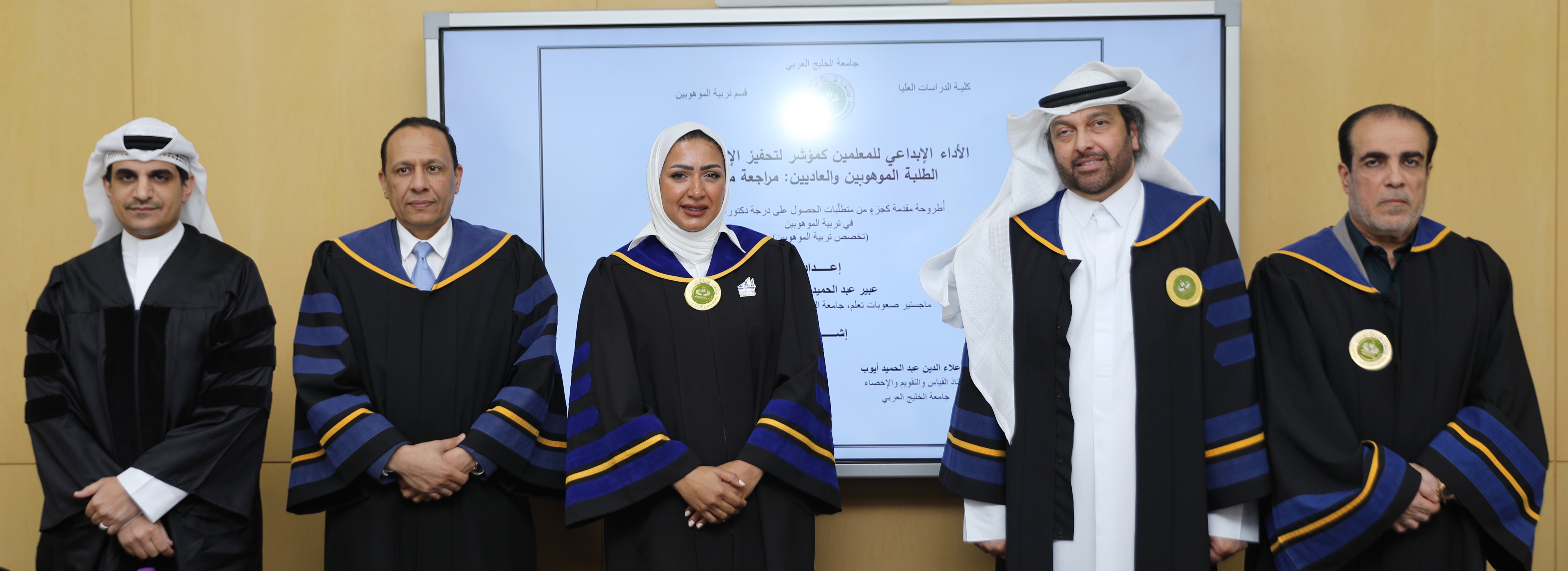
Study at the Arabian Gulf University Sheds Light on the Creative Performance of Teachers as an Indicator for Stimulating Creativity in Gifted and Regular Students
Arabian Gulf University
26 Sep, 2024
As part of the requirements for obtaining a Doctor of Philosophy degree in Special Education, with a focus on Gifted Education, Ms. Abeer Abdulhameed Haidar, a researcher at the Special Education Department within the Gifted Education Programme at the Arabian Gulf University (AGU), has discussed the results of her doctoral thesis titled “Creative Performance of Teachers as an Indicator for Stimulating Creativity in Gifted and Regular Students: A Systematic Review.”
The objective of the research was to identify the characteristics of teacher performance that stimulate creativity among gifted and regular students in Kuwait. Specifically, the study aimed to establish the correlation between the responses of students and teachers regarding the characteristics of teachers that foster creativity. Furthermore, it sought to highlight the differences in the responses of gifted and regular students concerning teacher-related characteristics and their levels of creativity. The researcher also aimed to uncover the predictive capacity of these teacher-related characteristics in stimulating creativity, as perceived by both teachers and students.
Utilising a descriptive methodology and conducting a systematic review of relevant studies, the research sample comprised 410 participants, including 205 teachers and 205 students. Among the students, 73 were identified as gifted, while 132 were regular students. The research instruments included a scale assessing teacher characteristics that stimulate student creativity (with separate versions for teachers and students) and a measure for evaluating levels of creativity.
The findings revealed the presence of eight factors associated with teachers that effectively stimulate creativity among students. Additionally, the results indicated a significant correlation between the responses of teachers and students across various dimensions, including classroom management, time management, creative thinking skills, research skills, social characteristics of the teacher, emotional characteristics of the teacher, and the creative learning environment. However, no correlation was found regarding teaching and learning strategies.
Moreover, the results demonstrated significant differences between the responses of gifted and regular students concerning teacher-related characteristics that stimulate creativity, with gifted students showing a marked advantage. The study concluded that certain teacher characteristics—namely creative thinking skills, teaching and learning strategies, social characteristics, research skills, and classroom management—possess predictive capabilities for stimulating creativity among gifted students from the perspective of teachers. Similarly, attributes such as classroom management skills, teaching and learning strategies, research skills, and social characteristics are predictive in fostering creativity among gifted students from the students’ viewpoint.
In light of her findings, the researcher recommended the training of teachers in employing and integrating teaching strategies that enhance creativity for both gifted and regular students. She urged educational authorities to acknowledge the importance of incorporating creative skills into the curricula, given their significant role in fostering student creativity. Furthermore, she emphasised the necessity of conducting studies focused on the development of creative skills among students, encouraging such growth through the characteristics of teachers.
Highlighting the critical need for teachers to possess social and emotional intelligence skills when interacting with students of varying abilities, the researcher called for the establishment of conducive environments that allow teachers to execute their instructional activities comfortably, ultimately reflecting positively on student creativity and innovation. She also advocated for the creation of a supportive atmosphere for creativity and continuous renewal, thereby fostering a culture of innovation where both students and teachers can engage in creative activities consistently. Lastly, she reiterated the call for training teachers in modern teaching and learning strategies that encourage student participation, interaction, and innovative problem-solving in educational settings, enabling them to acquire knowledge and skills in a more novel manner.
